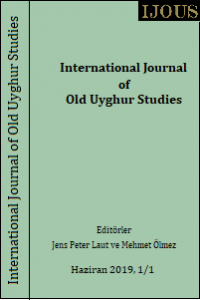
International Journal of Old Uyghur Studies
Yazarlar: ["Shynaray BURKİTBAYEVA"]
Konular:-
DOI:10.46614/ijous.1310195
Anahtar Kelimeler:Қазақ тілі,Көне ұйғыр тілі,Грамматикалық талдау,Салыстыру,Тарихи мағына
Özet: This paper compares the Old Uyghur language and the modern Kazakh language from a grammatical point of view (on the basis of grammatical analysis). Old Uyghur is a branch of the Old Turkic language, from which the modern Kazakh language, as well as other Turkic languages, originated. The main purpose of the article is to analyze the features of the Old Uyghur language, which is one of the least researched fields of the Turcology studies in Kazakhstan, by comparing it with the grammar of the Kazakh language. In the course of writing the article, it was revealed that the ancient Uyghur language used in the VIII-IX centuries and the modern Kazakh language have the same grammatical structure (except for minor differences). The use of root words in the modern Kazakh language and the affixes connected to them in the form that has not lost its original, historical meaning has been studied. In order to prove with examples, whole sentences were taken from the original text in the ancient Uyghur language and grammatically analyzed based on the standard of the modern Kazakh language. The article is based on the text named "Bugu Kagan's Acceptance of Manichaeism" written in Old Uyghur. This text, which was found during the German Turpan expedition, was written during the reign of the Uyghur Khanate in present-day Mongolia, by the third Uyghur Khagan (759-780) when he converted to Manichaeism in 762-763. The text we are using is an excerpt from the work of the Turkish scholar B. Özbay. The fact that most of the words in the text are preserved in modern Kazakh with little or no change increased our interest in the text to choose it for grammatical analyses and comparison. In the article, we tried to compare hundreds of words from a lexical point of view and analyze them as much as possible. In addition, during the preparation of the article, we once again observed how rich Kazakh vocabulary is in terms of Old Turkic words. This article aims to make both scholarly and practical contribution to the field. It can be used as a teaching material for the history of the Kazakh language and the history of the Turkic languages. In addition, this work is important in that it will contribute to filling the gap in the field of Old Uyghur studies, which is one of the least studied fields of the Turcology by Kazakh scholarship. The article uses comparative and diachronic comparative methods.